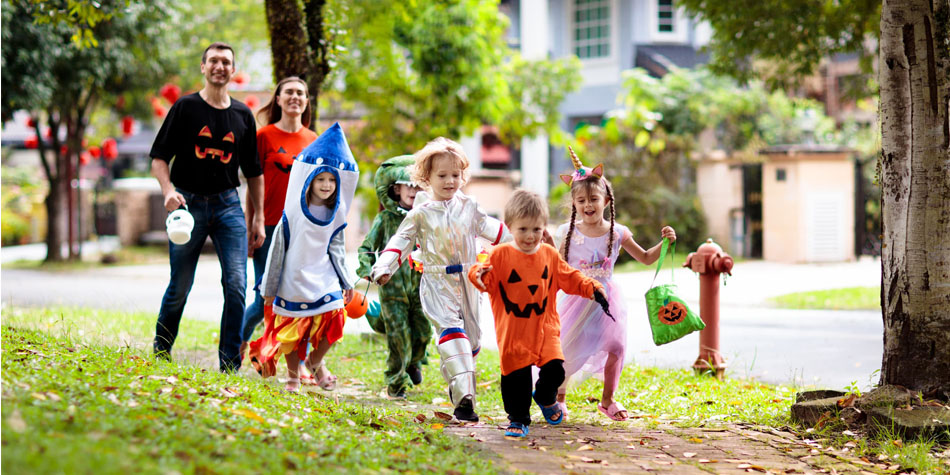
Trick-or-treating is often the highlight of Halloween, but safety is important.
Halloween is a beloved holiday by many, not just kids but also adults. While it's generally seen as a children's celebration, adults often join in the festivities, from themed parties to neighborhood events. To keep the emphasis on fun and avoid a trip to the emergency room, here are some practical Halloween safety tips.
Decorate with care
Halloween decorations have expanded well beyond the traditional pumpkin or hay bale. In 2023, Americans spent more than $5.5 billion on Halloween decorations. Whether you're planning to carve a jack-o'-lantern or erect a display of larger-than-life ghosts and goblins in your front yard, keep the following in mind:
- Carve with caution: Many Halloween-related emergency-room visits are related to pumpkin-carving. Encourage young children to create faces and designs on pumpkins with felt-tipped pens rather than using sharp instruments. Also, have a skilled adult cut off the top of the pumpkin, and use a blunt tool like a spoon or scraper to scoop out the pulp and seeds.
- Avoid real flames: Use flashlights or glow sticks instead of real candles to light jack-o'-lanterns.
- Gather together: Don't decorate alone, especially if you're going to be climbing ladders or working with electricity — two top reasons for emergency room visits. Make sure you check all wiring (including whether it is made for outdoor use) before plugging anything in.
- Keep things contained: Keep decorations out of the path of trick-or-treaters.
- Consider trick-or-treaters: Think carefully about decorations that make sounds or have flashing lights that can frighten young children or pets.
Select your costume carefully
Whether dressing up as a superhero or the celebrity of the moment, make sure your costume allows you to see and move safely. Halloween often comes with unknown terrain and plenty of other people who may not be paying close attention. Consider these tips:
- Shine bright, stay safe: Choose bright colors or add reflective tape to ensure visibility, especially when out trick-or-treating as the daylight fades.
- Check the labels: Use nontoxic face paint and makeup, and opt for clothing and accessories marked as flame-resistant.
- Nix tripping hazards: Make sure shoes and costumes fit properly, and be aware of anything draping or dragging to avoid tripping yourself or others.
- Dress for the forecast: If it's chilly or raining on Halloween, dress for the weather. Being cold or wet will quickly take the fun out of the occasion.
Choose your treats wisely
Food allergies add real-world risks for children and others with food allergies. About one in 13 children are allergic to foods such as nuts, milk and wheat — all of which are common ingredients in candy and other Halloween treats. If you're handing out candy this year, be aware of common allergens and select your treats wisely:
- Broaden the options: Choose a variety of candies and treats to give out so children with allergies are more likely to find something that they can eat. Small bags of chips or pretzels are good alternatives to milk- or nut-based candies.
- Offer non-food goodies: Consider handing out small takeaway items you can buy in bulk, like glow bracelets, temporary tattoos, spider rings or fidget toys. Just make sure its age appropriate for the trick-or-treater.
- Take extra precautions: If your child has allergies, make sure they travel with an EpiPen and put off eating candy until they get home so you can carefully look at labels and prevent exposure to allergies.
Trick-or-treat safely
Trick-or-treating is often the highlight of Halloween, but it's important to celebrate safely. The intersection of excited children crossing the street and drivers heading to events can be dangerous. Children are about twice as likely to be hit by a car on Halloween than any other day of the year.
Keep these guidelines in mind before heading out for the evening:
- Stick together: Young children should always trick-or-treat with an adult. To make it more fun, join up with another family. But remember, the focus is on the kids and safety — leave alcoholic beverages at home.
- Plan ahead: Help older children plan a safe route and times to check in with others along the way. Balance independence and safety.
- Go out early: Young children are usually just as happy trick-or-treating before dark. Head out at the start of the recommended hours for your neighborhood's festivities or look for daytime community gatherings like parades, trunk-or-treats or business-hosted events.
- Cross streets with care: Pay attention to traffic (including people on bikes and scooters) and cross at the corner or a crosswalk instead of in the middle of the street.
- Wait to indulge: Encourage your kids to avoid eating treats as soon as they get them. For one, you'll want to check the packaging first. But also, people who are focused on finding and opening candy or toys can become distracted pedestrians who aren't watching out for themselves or others.
Beware while on the roads
Halloween and the early morning hours of the next day are prime time for drunken driving and traffic accidents. If you must drive on Halloween, take extra precautions and keep an eye out for trick-or-treaters and people who may be driving while impaired. If you're going to a party, choose a designated driver or arrange for a cab or ride share.
Be prepared to have fun
Halloween should be full of fun, not a surprise trip to urgent care. Whether you're wrangling little goblins or heading out with your own friends, keeping these simple Halloween safety tips in mind can ensure you, your children and those around you stay safe.